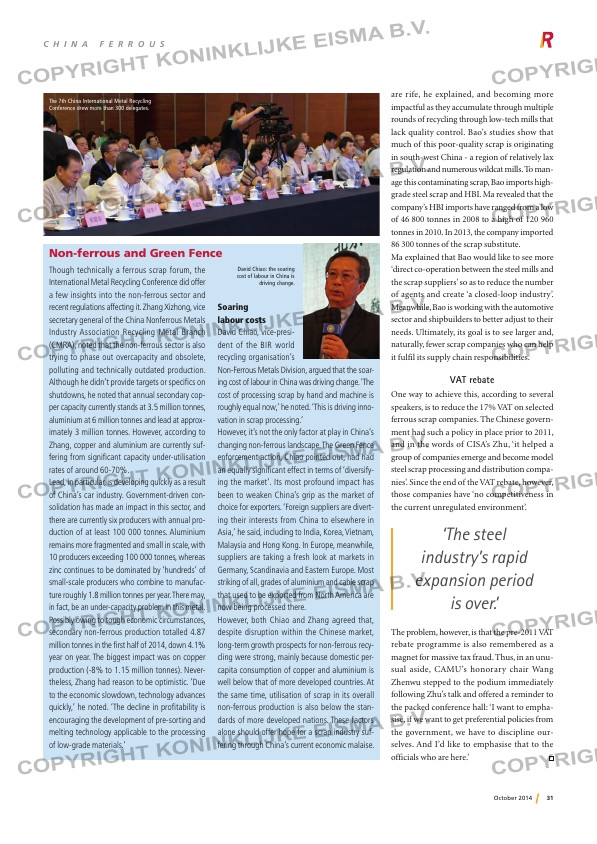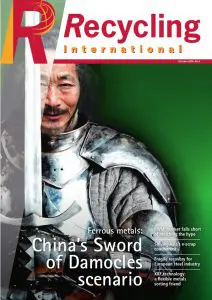Page 31 from: October 2014

31October 2014
C h i n a f e r r o u s
Though technically a ferrous scrap forum, the
International Metal Recycling Conference did offer
a few insights into the non-ferrous sector and
recent regulations affecting it. Zhang Xizhong, vice
secretary general of the China Nonferrous Metals
Industry Association Recycling Metal Branch
(CMRA), noted that the non-ferrous sector is also
trying to phase out overcapacity and obsolete,
polluting and technically outdated production.
Although he didn’t provide targets or specifics on
shutdowns, he noted that annual secondary cop-
per capacity currently stands at 3.5 million tonnes,
aluminium at 6 million tonnes and lead at approx-
imately 3 million tonnes. However, according to
Zhang, copper and aluminium are currently suf-
fering from significant capacity under-utilisation
rates of around 60-70%.
Lead, in particular, is developing quickly as a result
of China’s car industry. Government-driven con-
solidation has made an impact in this sector, and
there are currently six producers with annual pro-
duction of at least 100 000 tonnes. Aluminium
remains more fragmented and small in scale, with
10 producers exceeding 100 000 tonnes, whereas
zinc continues to be dominated by ‘hundreds’ of
small-scale producers who combine to manufac-
ture roughly 1.8 million tonnes per year. There may,
in fact, be an under-capacity problem in this metal.
Possibly owing to tough economic circumstances,
secondary non-ferrous production totalled 4.87
million tonnes in the first half of 2014, down 4.1%
year on year. The biggest impact was on copper
production (-8% to 1.15 million tonnes). Never-
theless, Zhang had reason to be optimistic. ‘Due
to the economic slowdown, technology advances
quickly,’ he noted. ‘The decline in profitability is
encouraging the development of pre-sorting and
melting technology applicable to the processing
of low-grade materials.’
Soaring
labour costs
David Chiao, vice-presi-
dent of the BIR world
recycling organisation’s
Non-Ferrous Metals Division, argued that the soar-
ing cost of labour in China was driving change. ‘The
cost of processing scrap by hand and machine is
roughly equal now,’ he noted. ‘This is driving inno-
vation in scrap processing.’
However, it’s not the only factor at play in China’s
changing non-ferrous landscape. The Green Fence
enforcement action, Chiao pointed out, had had
an equally significant effect in terms of ‘diversify-
ing the market’. Its most profound impact has
been to weaken China’s grip as the market of
choice for exporters. ‘Foreign suppliers are divert-
ing their interests from China to elsewhere in
Asia,’ he said, including to India, Korea, Vietnam,
Malaysia and Hong Kong. In Europe, meanwhile,
suppliers are taking a fresh look at markets in
Germany, Scandinavia and Eastern Europe. Most
striking of all, grades of aluminium and cable scrap
that used to be exported from North America are
now being processed there.
However, both Chiao and Zhang agreed that,
despite disruption within the Chinese market,
long-term growth prospects for non-ferrous recy-
cling were strong, mainly because domestic per-
capita consumption of copper and aluminium is
well below that of more developed countries. At
the same time, utilisation of scrap in its overall
non-ferrous production is also below the stan-
dards of more developed nations. These factors
alone should offer hope for a scrap industry suf-
fering through China’s current economic malaise.
David Chiao: the soaring
cost of labour in China is
driving change.
Non-ferrous and Green Fence
are rife, he explained, and becoming more
impactful as they accumulate through multiple
rounds of recycling through low-tech mills that
lack quality control. Bao’s studies show that
much of this poor-quality scrap is originating
in south-west China – a region of relatively lax
regulation and numerous wildcat mills. To man-
age this contaminating scrap, Bao imports high-
grade steel scrap and HBI. Ma revealed that the
company’s HBI imports have ranged from a low
of 46 800 tonnes in 2008 to a high of 120 960
tonnes in 2010. In 2013, the company imported
86 300 tonnes of the scrap substitute.
Ma explained that Bao would like to see more
‘direct co-operation between the steel mills and
the scrap suppliers’ so as to reduce the number
of agents and create ‘a closed-loop industry’.
Meanwhile, Bao is working with the automotive
sector and shipbuilders to better adjust to their
needs. Ultimately, its goal is to see larger and,
naturally, fewer scrap companies who can help
it fulfil its supply chain responsibilities.
VAT rebate
One way to achieve this, according to several
speakers, is to reduce the 17% VAT on selected
ferrous scrap companies. The Chinese govern-
ment had such a policy in place prior to 2011,
and in the words of CISA’s Zhu, ‘it helped a
group of companies emerge and become model
steel scrap processing and distribution compa-
nies’. Since the end of the VAT rebate, however,
those companies have ‘no competitiveness in
the current unregulated environment’.
The problem, however, is that the pre-2011 VAT
rebate programme is also remembered as a
magnet for massive tax fraud. Thus, in an unu-
sual aside, CAMU’s honorary chair Wang
Zhenwu stepped to the podium immediately
following Zhu’s talk and offered a reminder to
the packed conference hall: ‘I want to empha-
sise, if we want to get preferential policies from
the government, we have to discipline our-
selves. And I’d like to emphasise that to the
officials who are here.’
‘The steel
industry’s rapid
expansion period
is over.’
The 7th China International Metal Recycling
Conference drew more than 300 delegates.
RI8-China.indd 31 06-10-14 14:09



